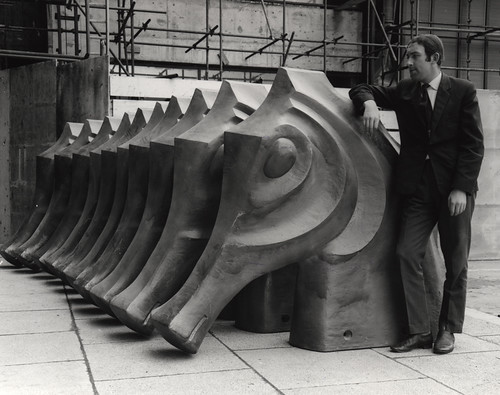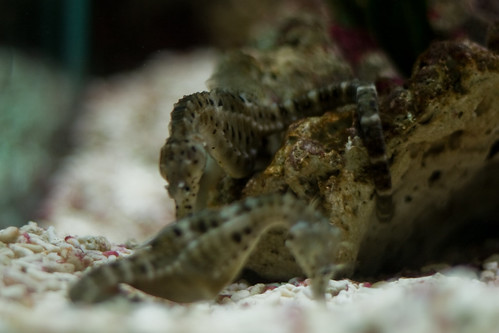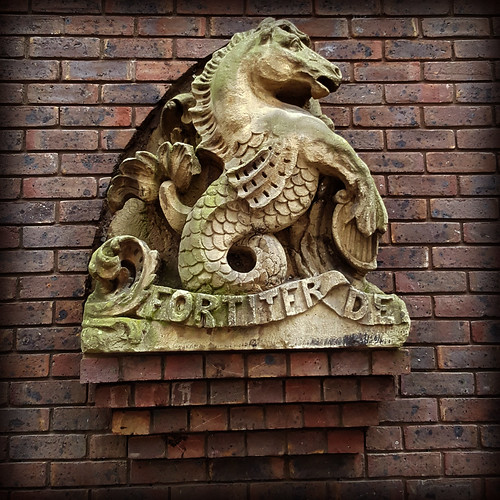Seahorses are elusive creatures, almost like a mythological animal made flesh. They appear in Roman and Greek mythology, pulling either Neptune or Poseidon’s chariot.
Either Poseidon was very small, or he had extra large seahorses, but it’s a cool image all the same. Others believe Poseidon actually rode a seahorse, which is even cooler. Their links with Poseidon give the seahorse a sense of strength and power.
Poseidon’s seahorses followed the half horse, half fish model. Even the Romans followed a similar depiction; you can see a seahorse mosaic at the Roman baths in Bath that features the same type of seahorse.

The birth of the scientific age meant that, by the 19th century, aquariums popped up where scientists could study seahorses. That said, an animal with a horse-like head and a monkey-like tail is just as weird as the Roman version.
I decided to further look into seahorses after showing a friend around Newcastle’s city centre. After all, the city’s crest features two seahorses, green with gold manes, fins and tails. Added to the shield back in 1575, they act as a reminder that Newcastle is essentially a port.
A ring of seahorse heads surrounds the Civic Centre’s tower, again nodding to Newcastle’s sea-based heritage, which also links with the River God Tyne.

These sculptures, designed by J.R. McCheyne, prompted me to ask…
Are there any seahorses in folklore?
The answer, as you’ve probably guessed, is yes. They don’t just appear in mythology.
According to this website, many believed that seahorses protected the souls of dead sailors on the way to the underworld. It’s hardly surprising that sailors viewed seahorses as good luck charms. (Good to know, I’ve got a huge bronze seahorse pendant!)
Helen Scales points out that fishermen sometimes caught seahorses in their nets, and they believed them to be “the tiny offspring of Poseidon’s mighty steeds” (2009).
Because many view them as calm and mild-mannered, the seahorse also represents patience and contentment. They’ve never really evolved much, so some believe they represent both stubbornness and an acceptance of the self. In Native American folklore, they represent grace and confidence.

Howard J. Sherman relates a folktale about the Yupit people of Siberia and seahorses. In the story, an old man catches two seahorses and ties them to his belt. They symbolise good luck to the Yupit. After losing his only son to the Ruler of the Sea, the old man gives him the seahorses to retrieve his child (2014).
Traditional Chinese medicine uses them to treat ailments as varied as asthma, sexual dysfunction and kidney problems. This leads to the alarming practice of seahorse farming, which decimates their numbers.
They’re fascinating animals, particularly since they’re the only species on earth where the male gives birth.

But seahorses and Newcastle?
So bearing all of this in mind, can there be any other reasons why seahorses would appear on the Newcastle upon Tyne crest?
I like to think that maybe the acceptance of the self refers to the innate pride of the Geordies. We don’t try to be anyone else – we’re who we are. We’re not famous for being calm or mild-mannered but like the seahorse, holding tight to the seaweeds, we hang on and weather rough storms.

The River God Tyne refers to the Roman belief in the genius loci, present in the river Tyne, so maybe the seahorses also point to Neptune’s steed of choice. Neptune, and Oceanus, both have ties to Newcastle through its original Roman occupation.
As a Roman settlement, Pons Aelius, the city would be keen to forge links with powerful deities. That’s particularly important since we’re so far from Londinium (London) and were the last major settlement before Hadrian’s Wall.

Either way, I’m quite proud to be associated with such wonderful animals!
What animals are present in your city’s crest, and do you know why they’re there?
Why not sign up below and get a guide to protecting your home using folklore?
References
Scales, Helen (2009), Poseidon’s Steed: The Story of Seahorses, From Myth to Reality, London: Penguin.
Sherman, Howard J. (2014), World Folklore for Storytellers: Tales of Wonder, Wisdom, Fools, and Heroes, Abingdon: Taylor & Francis.
Nutty about folklore and want more?
Add your email below and get these posts in your inbox every week.
You'll also get my 5-step guide to protecting your home using folklore!








Excellent post… there is a well known belief which says that seahorses stay faithful to their mate for ever, I don´t know if it is true though…
Also, you are right as to how they are linked to Poseidon i.e Neptune… In fact there are depicted in a quite literal way, keeping in mind their name, as fish tailed horses. Sea- horses. You can check it out in this image https://aquileana.files.wordpress.com/2015/01/poseidon-chariot.jpg
References image. On the Left: Mosaic: Poseidon rides across the sea in a chariot drawn by two Hippokampoi (fish-tailed horses. 3rd century AD. On the Right: Poseidon with trident on hand driving a chariot, drawn by two Hippokampoi. 3rd century AD.
I love seahorses. They’re such unusual little animals.
I’ve been trying to ‘capture’ the seahorses of Newcastle https://www.instagram.com/explore/tags/newcastleseahorses/
A noble goal!
This was an interesting post. Well-researched, and I enjoyed the pictures of the sculptures.
Also, apparently, my spirit animal is the wren.
That’s so cool!
Thank you for sharing this wonderful article on seahorses. I appreciate the reference to genius loci. Horseheads, NY is nearby me, a place my great grandmother once lived before the family went to California. I will look into it.
Carolyn aka Dr Clark of MythologyTweets